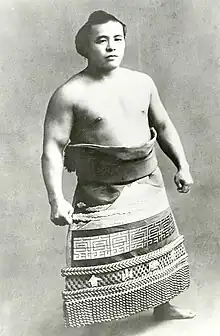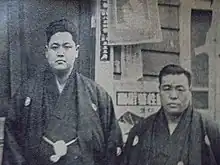Ōnosato Mansuke
Ōnosato Mansuke (Japanese: 大ノ里 萬助, born Mansuke Tennai (天内 萬助), April 1, 1892 - January 22, 1938) was a Japanese professional sumo wrestler from the Minamitsugaru District (now Fujisaki) in the Aomori Prefecture.[1] Nicknamed Sumō no kami-sama (相撲の神様), meaning 'Sumo god',[2] he was one of the leaders of the Shunjuen Incident.
| Ōnosato Mansuke | |
|---|---|
| 大ノ里 萬助 | |
 | |
| Personal information | |
| Born | Mansuke Tennai April 1, 1892 Fujisaki, Aomori Prefecture |
| Died | January 22, 1938 (aged 45) Dalian, Manchuria |
| Height | 1.64 m (5 ft 4+1⁄2 in) |
| Weight | 97 kg (214 lb; 15.3 st) |
| Career | |
| Stable | Dewanoumi |
| Record | 262-160-22-8d-4h |
| Debut | January 1912 |
| Highest rank | Ōzeki (January 1925) |
| Retired | January 1932 |
| Gold Stars | 2 (Ōtori, Nishinoumi III) |
| * Up to date as of March 6, 2023. | |
History
Born on April 1, 1892, in Aomori Prefecture. He decided to join professional sumo in 1910 after a touring team came to Fujisaki in the summer. [3] Even though he had a small stature, his enthusiasm earned him admission in the Dewanoumi stable, and he stepped in the ring for the first time in 1912. Although he was a small fighter, he rose through the ranks through hard work and diligence. However, as might be expected, he was unable to achieve good results at the higher ranks at first due to the weaknesses of his small stature. Ōnosato was however promoted komusubi and sekiwake in the 1922 tournaments. He earned a promotion to the rank of ōzeki in the May 1925 tournament. At the time, he was the fourth ōzeki from Aomori Prefecture and the first promoted at this rank in 55 years, after Ichinoya's promotion in 1889.[4] He held the rank for 7 straight years. Ōnosato earned the nickname 'Sumo god' because of his warm personality and his enthusiastic guidance of young wrestlers, and he became popular with many rikishi.[3]
The Shunjuen Incident

Ōnosato became one of the leader of the Shunjuen Incident that broke out on January 6, 1932. One day after the January banzuke release, 32 Dewanoumi ichimon (clan) wrestlers gathered at a Chinese restaurant named Shunjuen, located in Tokyo's Oimachi district. They demanded full scale reforms from the Japan Sumo Association to improve the wrestlers living conditions. Subsequently, a number of sekitori from a non-Dewanoumi ichimon, including then sekiwake Minanogawa, joined the protest . The Association was faced with an unprecedented crisis never before seen in the history of professional sumo and responded quickly to the group's demands, but their responses were considered to be half-hearted and lacking in substance, and eventually, the negotiations collapsed.[5]
Just like his comrade Tenryū Saburō, Ōnosato cut off his ōichōmage top knot
[6] and founded with the secessionists the Kansai Sumo Association (Kansai Kakuryoku Kyokai, 関西角力協会) where he wrestled until 1935. He then served as chairman of this association but his declining health precipitated the fall of the organization and the wrestlers came back to Tokyo.[7]
Fighting style
Ōnosato was known for his short stature and had to compensate for this weak point with his technique. He was particularly known for his tachi-ai and use of the roundness of the ring.[2]
Death and homage
Ōnosato, among the wrestlers of the Kansai Sumo Association, took part in a tournament in Manchuria in 1933. The tournament was to be held to put his association back on track after several successive failures and the desertion of several wrestlers who returned to the Sumo Association in Tokyo. He fell ill and was admitted to a Red Cross hospital in Dalian. He died of pleurisy in January 1938, at the age of 45, after a long illness.[7] The day after the news of Onosato's death, the Dewanoumi ichimon received a final letter from Ōnosato in which he expressed his concern and encouragement for his Kansai disciples who had returned to the stable.[3]
On August 1, 1960, a monument was unveiled in the precincts of Kashima Shrine in his hometown of Fujisaki and a competition for elementary school students of the Aomori Prefecture, called the "Ōnosato Cup Youth Sumo Tournament", is held every year in August in that shrine.[8] On February 4, 2023, several of his belongings were donated to his hometown of Fujisaki. The objects were in possession of the family of Ōnosato's former patron. Among the dozen of valuable materials, photographs, his akeni (明荷, sumo luggage) and a keshō-mawashi were donated.[9]
Top Division Record
| - | Spring | Summer | ||||
|---|---|---|---|---|---|---|
| 1913 | East Jonokuchi #20 4–1 | East Jonidan #60 4–1 |
||||
| 1914 | East Sandanme #69 4–1 | East Sandanme #28 4–1 |
||||
| 1915 | West Makushita #55 3–1 1d | West Makushita #45 4–0 1d |
||||
| 1916 | East Makushita #16 4–1 | East Jūryō #14 5–0 |
||||
| 1917 | East Jūryō #4 4–3 | East Jūryō #2 3–3 |
||||
| 1918 | East Jūryō #4 6–1 | East Maegashira #15 4–5 1d |
||||
| 1919 | East Maegashira #14 8–1 1h | East Maegashira #5 5–4–1 |
||||
| 1920 | East Maegashira #4 7–2 1d ★ | West Maegashira #1 2–8 |
||||
| 1921 | West Maegashira #6 2–6 2h | East Maegashira #9 7–2–1 |
||||
| 1922 | East Komusubi #1 6–3 1d | West Sekiwake #1 5–3 2d |
||||
| 1923 | East Sekiwake #1 4–6 | West Maegashira #1 6–4 1h ★ |
||||
| 1924 | West Sekiwake #1 7–2 1d | East Sekiwake #1 9–2 |
||||
| 1925 | Sat out | West Ōzeki #1 4–3–4 |
||||
| 1926 | West Ōzeki #1 7–4 |
East Ōzeki #1 8–3 |
||||
| Record given as win-loss-absent Top Division Champion Top Division Runner-up Retired Lower Divisions Key: ★=Kinboshi(s); d=Draw(s) (引分); h=Hold(s) (預り) | ||||||
| - | Spring Haru basho, Tokyo |
March Sangatsu basho, varied |
Summer Natsu basho, Tokyo |
October Jūgatsu basho, varied | ||
|---|---|---|---|---|---|---|
| 1927 | West Ōzeki #1 6–5 |
West Ōzeki #1 9–2 |
West Haridashi Ōzeki 2–6–5 |
East Ōzeki #1 8–3 |
||
| 1928 | East Haridashi Ōzeki 3–3–5 |
West Haridashi Ōzeki 8–3 |
West Haridashi Ōzeki 6–5 |
West Haridashi Ōzeki 6–5 |
||
| 1929 | East Haridashi Ōzeki 6–5 |
East Haridashi Ōzeki 6–5 |
East Haridashi Ōzeki 6–5 |
East Haridashi Ōzeki 7–4 |
||
| 1930 | East Ōzeki #1 6–5 |
East Ōzeki #1 7–4 |
East Ōzeki #1 9–2 |
East Ōzeki #1 6–5 |
||
| 1931 | West Ōzeki #1 6–5 |
West Ōzeki #1 7–4 |
East Ōzeki #1 4–7 |
East Ōzeki #1 4–7 |
||
| 1932 | East Ōzeki #9 Retired 0–0 |
|||||
| Record given as win-loss-absent Top Division Champion Top Division Runner-up Retired Lower Divisions Key: ★=Kinboshi(s); d=Draw(s) (引分); h=Hold(s) (預り) | ||||||
References
- "Onosato Mansuke Rikishi Information". Sumo Reference. Retrieved 2023-03-06.
- "The "God of Sumo" Onosato and Hatasegawa". Sumo Rikishi database. 3 April 2017. Retrieved 1 March 2023.
- "Onosato Monument - Michinoku Yuyuu Chronicles". Michinoku Tourism Agency. 4 November 2012. Retrieved 1 March 2023.
- "Wrestlers from Aomori Prefecture by rank". SumoDB. Retrieved 11 September 2023.
- Kuroda, Joe. "Rikishi of Old: Tenryu Saburo and Shunjuen Incident". Sumo FanMag. Retrieved 1 March 2023.
- "Onosato Mansuke". Sumo Rikishi database. 8 March 2017. Retrieved 1 March 2023.
- "32 rikishi cut off their mage and holed up in a ryotei restaurant...What was the "Shunjuen Incident" that caused a stir in sumo 90 years ago? (part 2)". Bunshun Magazine (in Japanese). 31 January 2020. Retrieved 11 March 2023.
- "Onosato Cup Youth Sumo Tournament". Fujisaki town website. Retrieved 1 March 2023.
- "Akeni of Onosato donated to Fujisaki Town". TooNippo press agency. 4 February 2023. Retrieved 1 March 2023.